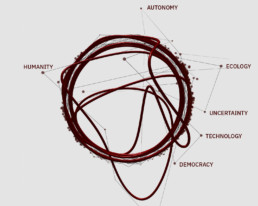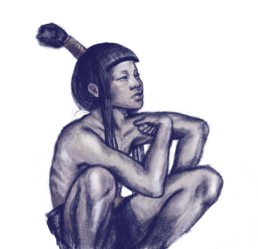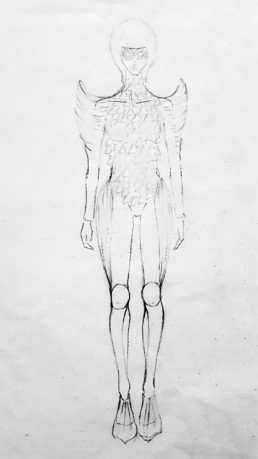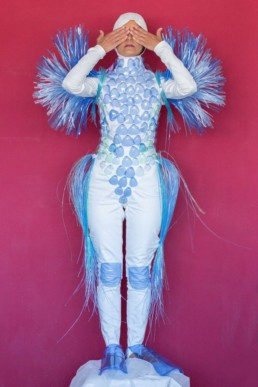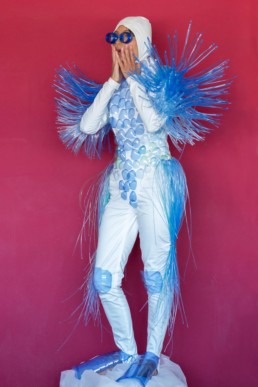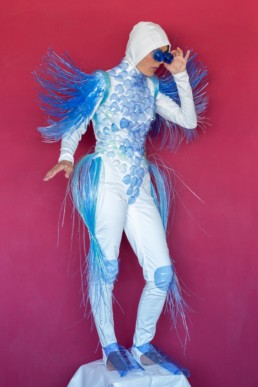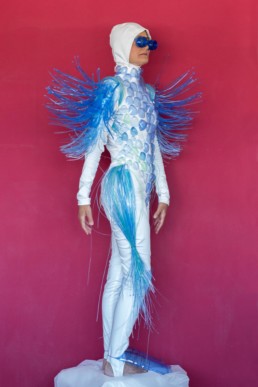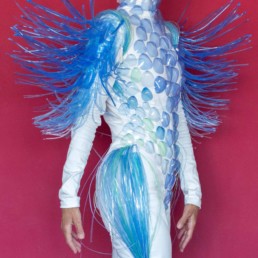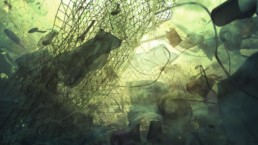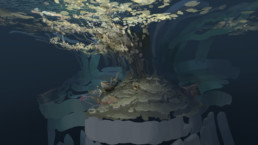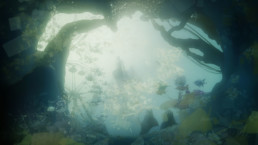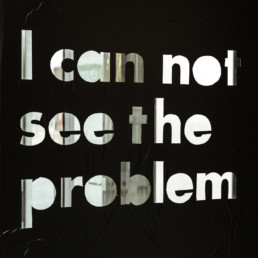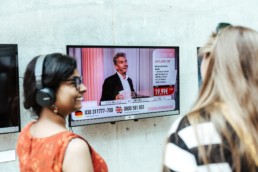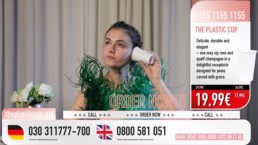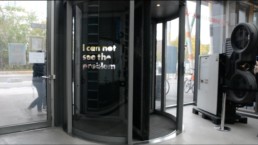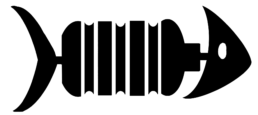Mantu
15-year-old Mantu is a true nature boy from the tribe of the Sea Residents. Living in harmony with nature, they give anything they take from nature back in a different form. However, with fish populations declining and more and more plastic ending up in the fishing nets, the tribal elders no longer know how to ensure the survival of their people. That‘s why they send Mantu on a mission to find a solution and to unravel the mystery of how plastic gets into the ocean. Knowing that the future of his tribe is at stake, Mantu takes his task very seriously.
Mantu is fearless. He knows how to read tracks, build a bow, and speak the language of animals. He is free and without possessions. On the water, he rides his surfboard. He doesn‘t have the complex textbook knowledge that Camilla has and acts based on instincts and experiences. Emotions are his weakness: Unable to hide them out of politeness, he easily gets upset when something is annoying him. Sometimes this is a good thing, but in some situations, it makes things more complicated. On their journey, it takes Camilla and Mantu some time to get it together. Even though they need, complement, and can learn from each other, things aren‘t always easy between them. And when both are determined to prove their point, things start getting funny.
Listen to the audio book part 3
360° VR FilmUnderwater-Attractions with Mermaid-Tower
DESKTOP
Use your mouse to click and drag the film to look around
PHONE
You can tap and drag on mobile or simply look around
VR
Become immersed in VR with a high-end headset
Artistic Research: Reflections about Plastic
Results from the International Masterclass Artistic Research:
Transmedia Storytelling - Camilla Plastic Ocean Plan at Filmuniversity Babelsberg 2019
SHOW US YOUR OWN IDEAS ON INSTAGRAM OR VIA EMAIL (max 10mb)
Why do biologistscare about plastics?
Dr. Lars Gutow
wrote his doctoral thesis at the Helgoland Biological Institute of the Alfred Wegener Institute (AWI), Helmholtz Centre for Polar and Marine Research.
As an environmental researcher, Gutow explores the impact of environmental changes on marine ecosystems. In particular, he focuses on how plants and animals in the oceans react to environmental changes caused by humans – such as climate change. For some 15 years, he has been conducting research on how plastic and microplastic pollution affects the structure and function of ocean ecosystems.
Organic chemistry is the science of carbonic compounds. Following this definition, plastics, which are primarily carbon based, are ‘organic’. However, our common perception of plastics is everything but ‘organic’ in the sense of ‘natural’. Plastics are entirely man-made, synthetic, and non-natural. Why then do biologists care about plastics?
As a marine biologist, I am working in the most exciting natural habitats of the oceans, including the extensive kelp forests along the Pacific coast of South America, the harsh but incredibly beautiful wilderness of the Arctic, the scenic intertidal flats of the Wadden Sea, and the hypnotically deep-blue waters of the open ocean. On my expeditions, I encounter the most fascinating and colorful plants and animals and I learned what it means to enjoy the privilege to join the same era as the most gigantic creatures that ever lived on our planet.
So, why then should I care about plastics? The ocean caps everything and all is nothing without the ocean. However, the fascinating creatures and ecosystems of the oceans are vulnerable. Wherever I go on my expeditions I encounter foot prints of human activity. Global climate change, over-exploitation of natural resources, and eutrophication are environmental stressors that affect marine wildlife in all parts of the world’s oceans. Within just a few centuries human activities have deteriorated numerous natural habitats. The gigantic ocean buffers the consequences of our activities for quite some time until they become evident. How can you see ocean warming and acidification? How can we see fish stocks declining below the ocean surface?
But plastics is different! Large-scale industrial production started not before the middle of the 20th century. Already in the 1950s, the first records of seabirds entangled in plastics were described in the scientific literature. Conspicuous quantities of plastics in the open ocean were reported already in the 1970s. Meanwhile, we encounter plastics in virtually every marine habitat even in the remotest regions of the oceans far away from the centres of human activity.
For a marine biologist it is simply impossible to ignore the plastic pollution of the oceans and it is my deep will and my profession to address this environmental problem scientifically. I document the contamination of the oceans by plastics and I investigate the effects of the plastic pollution but I had to realize that often I am just the poor guy who delivers the bad news, which is often deeply buried in the scientific literature and not accessible to the broad public. However, solving global environmental problem requires societal and economic changes and the first step on this away is a broad public awareness for the problems.
Accordingly, I have to break fresh ground, off the beaten academic track I was taught during my scientific education. Camilla Plastic Ocean Plan is a unique opportunity for a trans-disciplinary collaboration between artists and scientists from various fields. It allows me to contribute my scientific expertise to bring the message of ocean plastic pollution to the consciousness of people all over the world. The collaboration with film artists, graphic designers, and philosophers as well as the exchange with creative people during the International Masterclass Artistic Research „Transmedia Storytelling: Camilla Plastic Ocean Plan“ held in 2019 at the Filmuniversität Babelsberg Konrad Wolf expanded my view on the many exciting ways to tackle global environmental problems. If a charismatic character like Camilla is able to change the mind of just a few people, I know my time was not wasted.
Charlotte Hintzmann: Scientific Illustrations, Storydevelopment, Research | Dr. Lars Gutow: Scientific Partner | Torben Ratzlaff: Technical Support Scrollytelling | Martin Kammler, Stefan Winter, Matthias Ries, Marie Seeberger: Proofreading
